Abstract
Pathogenic free-living amoebae are common in nature, but few clinical infections by these amoebae have been reported. This has prompted studies of host susceptibility factors in humans. A survey of normal human sera from three New Zealand Health Districts was made; antibodies to pathogenic free-living amoebae were found in all sera, with titers ranging from 1:5 to 1:20 for Naegleria spp. and from 1:20 to 1:80 for Acanthamoeba spp. The antibodies belonged mainly to immunoglobulin G and immunoglobulin M classes. The presence of a specific neutralizing factor against Acanthamoeba spp. but not Naegleria spp. was demonstrated. Possible protective mechanisms are discussed.
Full text
PDF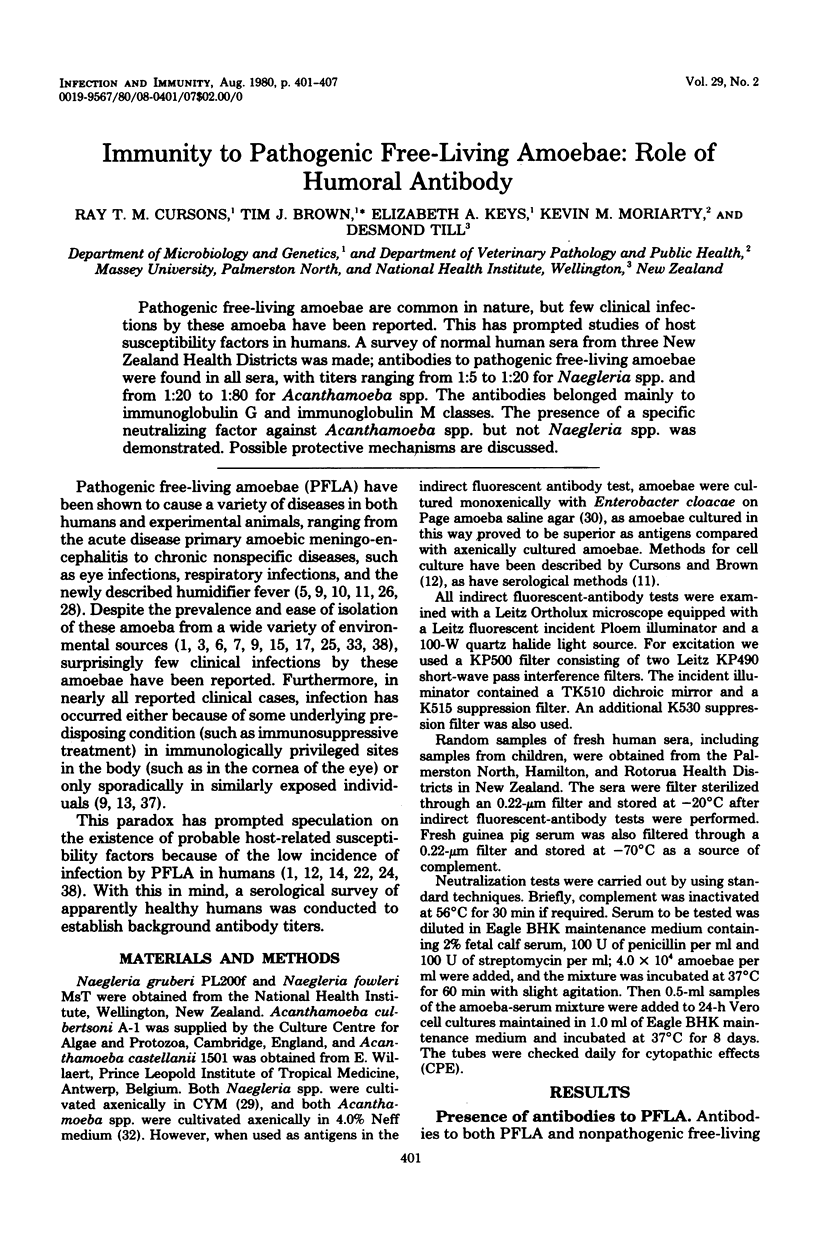
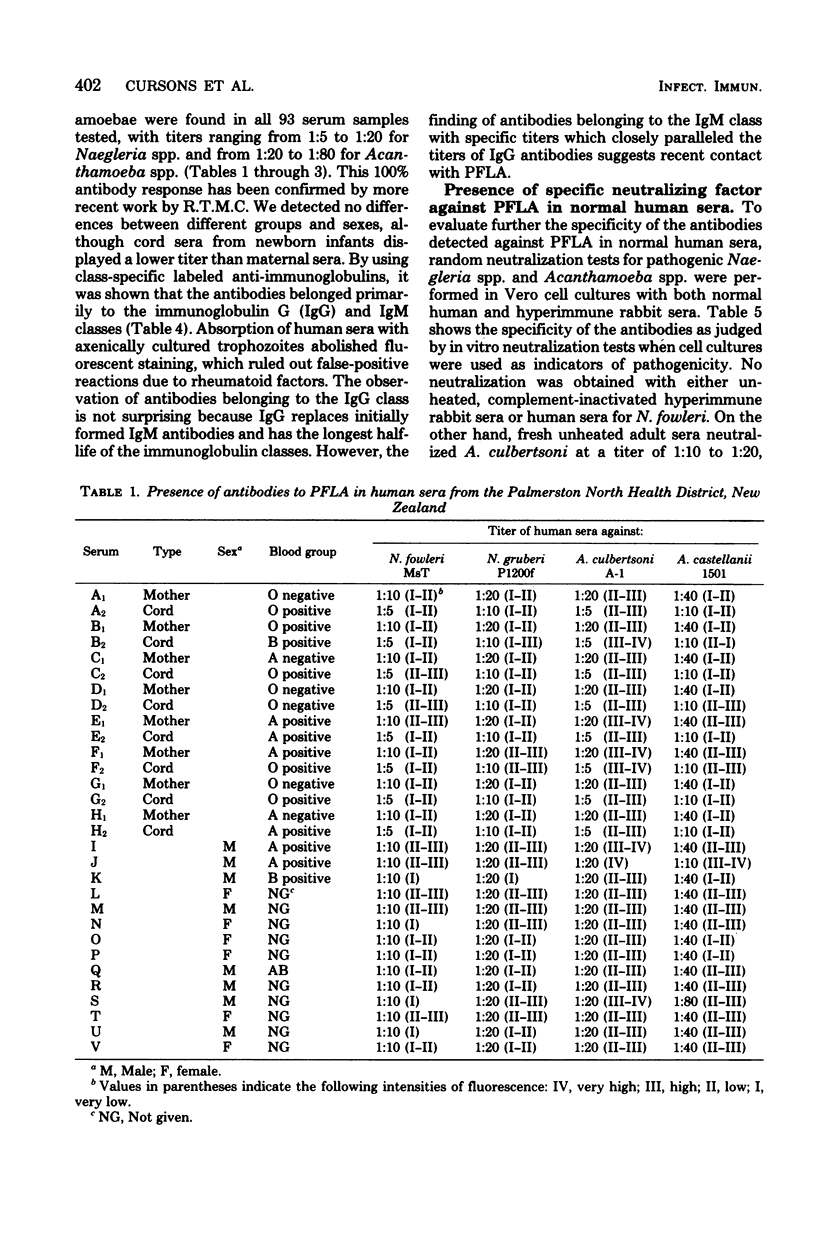
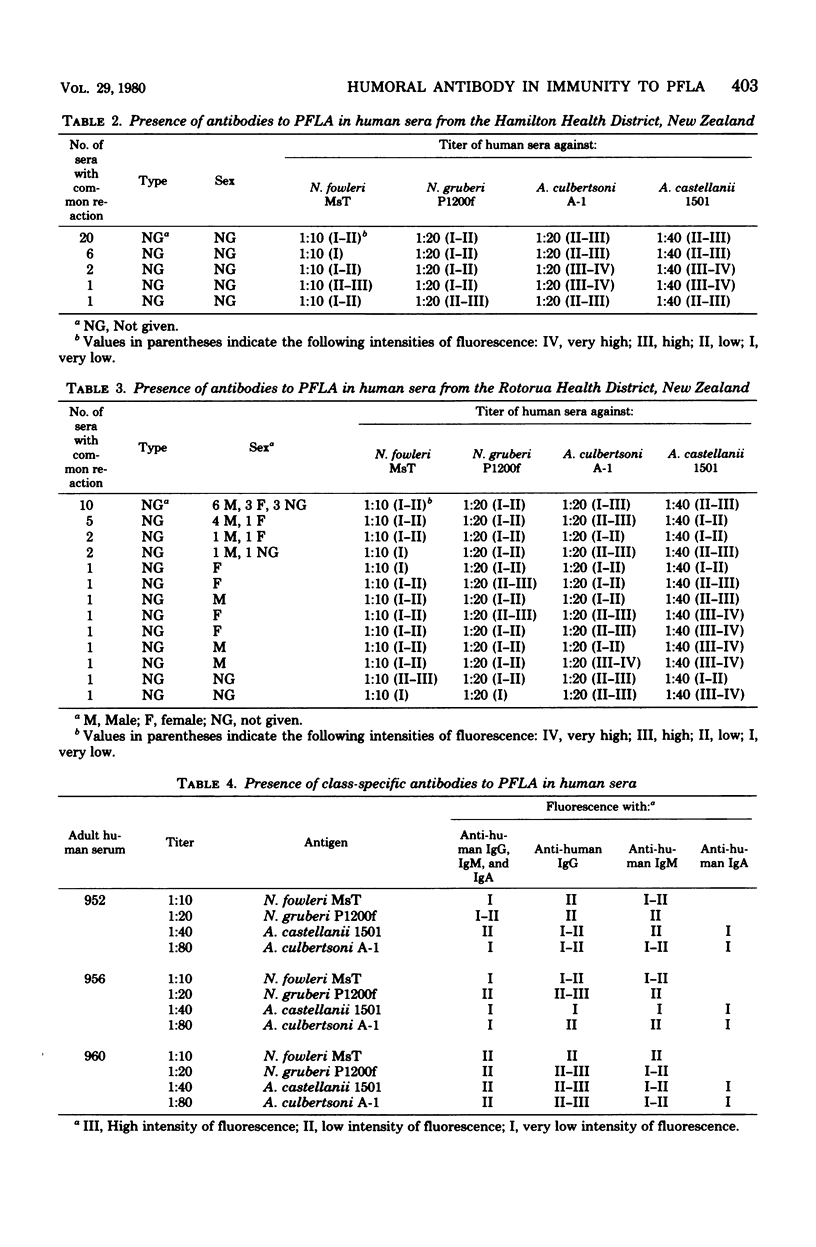
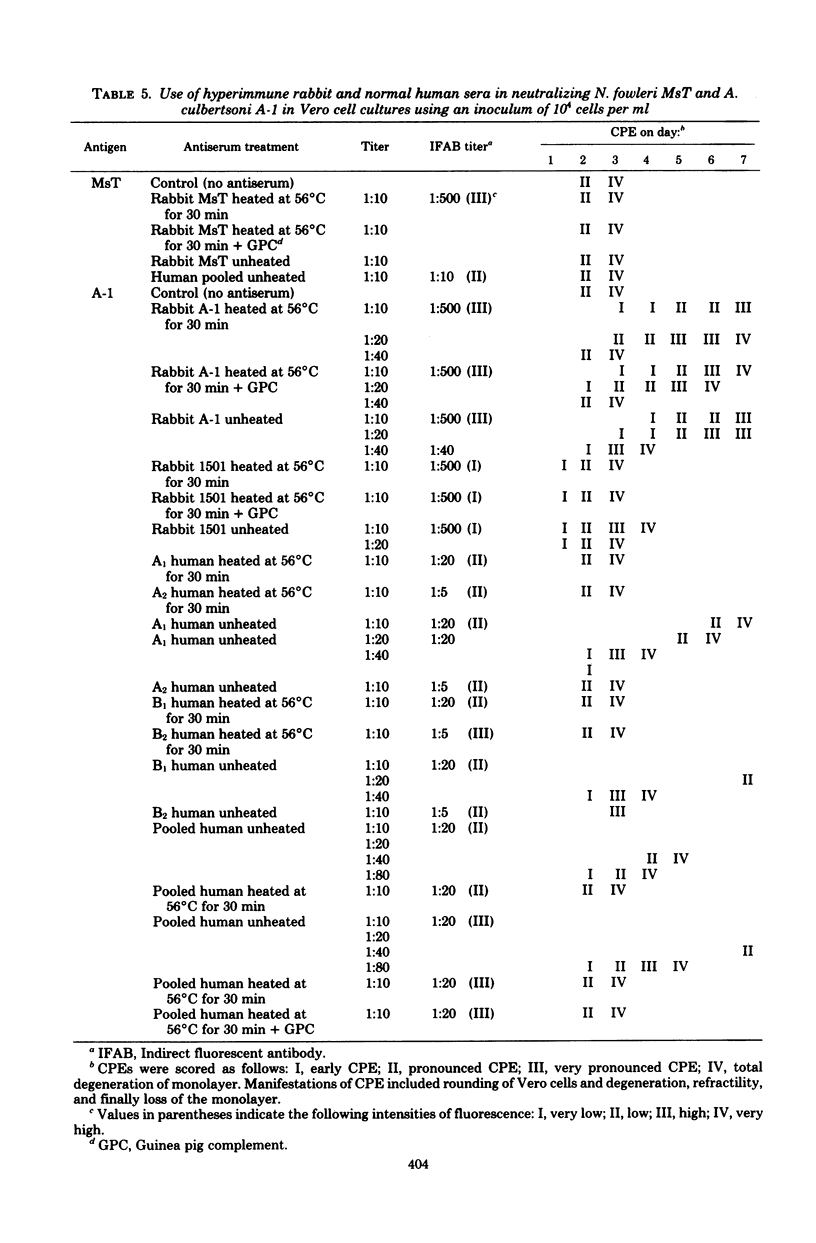
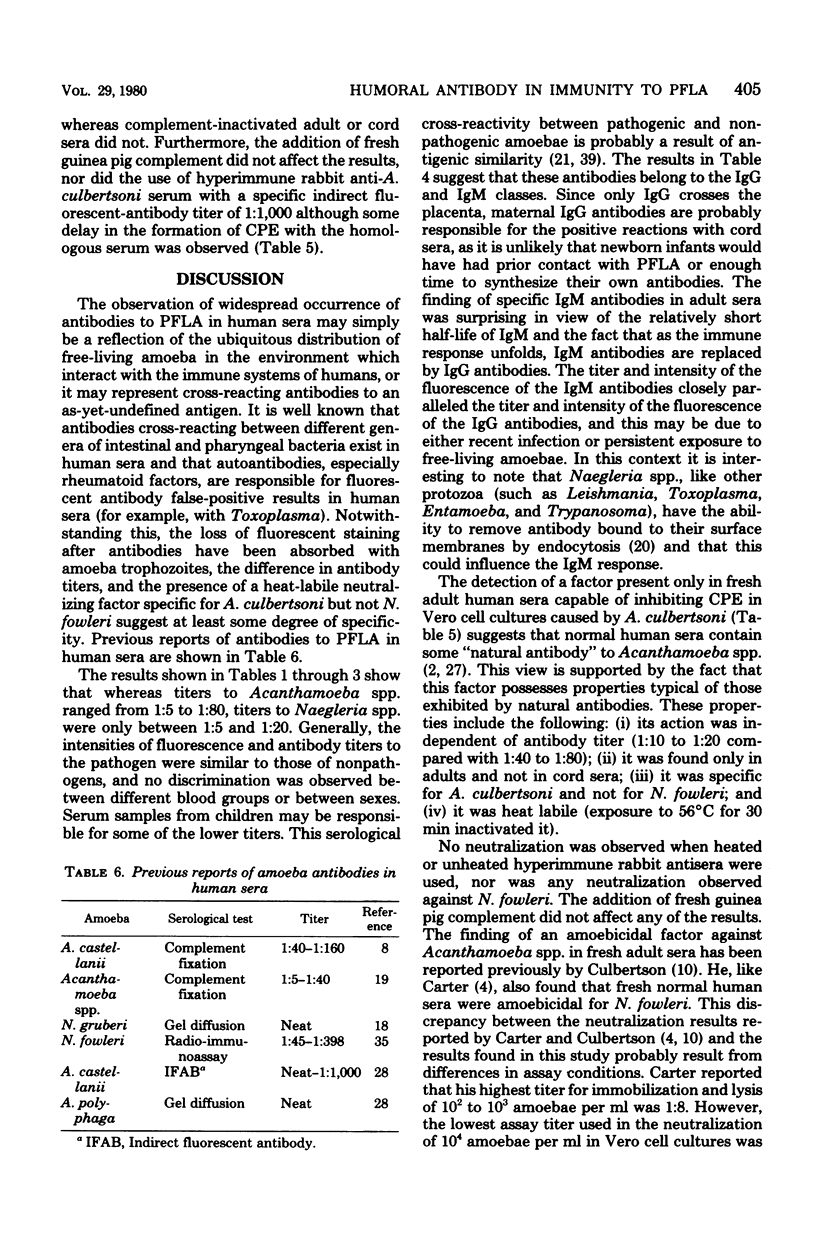
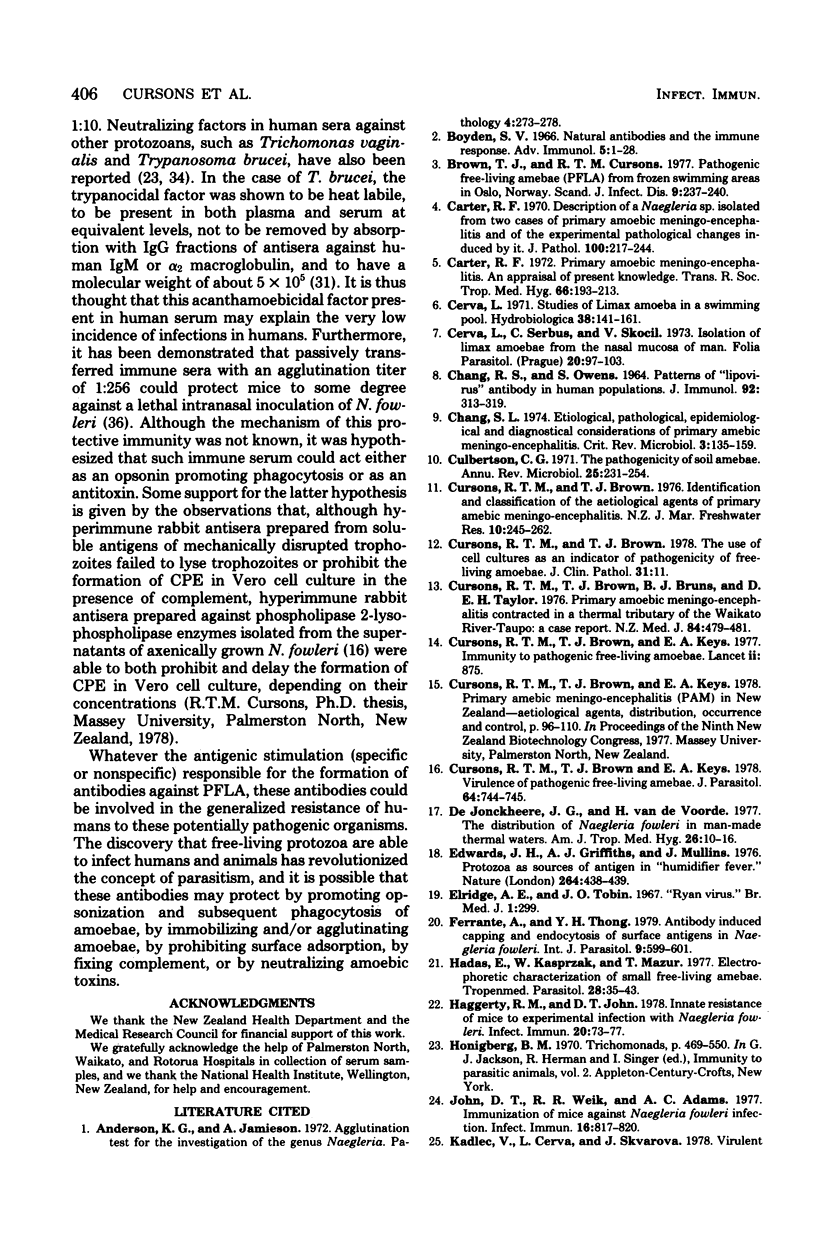
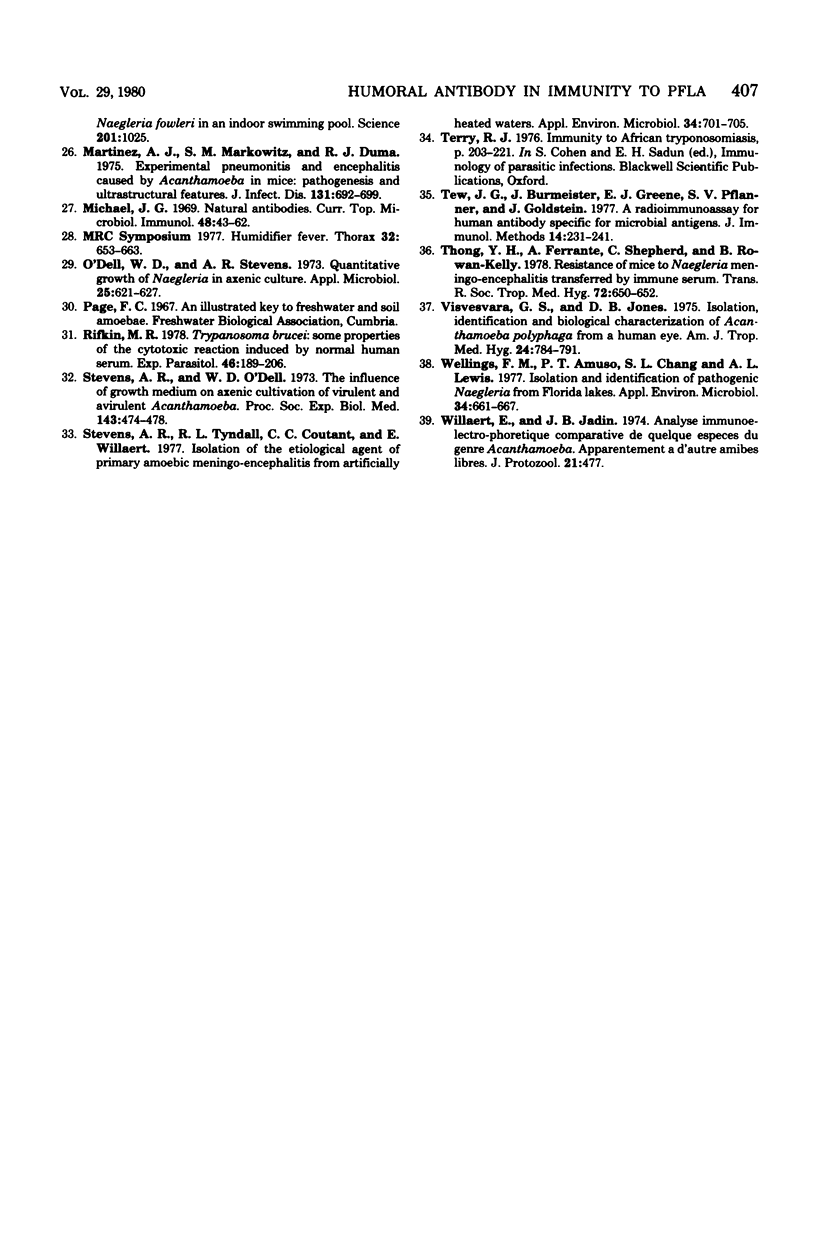
Selected References
These references are in PubMed. This may not be the complete list of references from this article.
- Boyden S. V. Natural antibodies and the immune response. Adv Immunol. 1966;5:1–28. doi: 10.1016/s0065-2776(08)60271-0. [DOI] [PubMed] [Google Scholar]
- Brown T. J., Cursons R. T. Pathogenic free-living amebae (PFLA) from frozen swimming areas in Oslo, Norway. Scand J Infect Dis. 1977;9(3):237–240. doi: 10.3109/inf.1977.9.issue-3.16. [DOI] [PubMed] [Google Scholar]
- CHANG R. S., OWENS S. PATTERNS OF "LIPOVIRUS" ANTIBODY IN HUMAN POPULATIONS. J Immunol. 1964 Feb;92:313–319. [PubMed] [Google Scholar]
- Carter R. F. Description of a Naegleria sp. isolated from two cases of primary amoebic meningo-encephalitis, and of the experimental pathological changes induced by it. J Pathol. 1970 Apr;100(4):217–244. doi: 10.1002/path.1711000402. [DOI] [PubMed] [Google Scholar]
- Carter R. F. Primary amoebic meningo-encephalitis. An appraisal of present knowledge. Trans R Soc Trop Med Hyg. 1972;66(2):193–213. doi: 10.1016/0035-9203(72)90147-2. [DOI] [PubMed] [Google Scholar]
- Cerva L., Serbus C., Skocil V. Isolation of limax amoebae from the nasal mucosa of man. Folia Parasitol (Praha) 1973;20(1):97–103. [PubMed] [Google Scholar]
- Culbertson C. G. The pathogenicity of soil amebas. Annu Rev Microbiol. 1971;25:231–254. doi: 10.1146/annurev.mi.25.100171.001311. [DOI] [PubMed] [Google Scholar]
- Cursons R. T., Brown T. J., Bruns B. J., Taylor D. E. Primary amoebic mengingoencephalitis contracted in a thermal tributary of the Waikato River--Taupo: a case report. N Z Med J. 1976 Dec 22;84(578):479–481. [PubMed] [Google Scholar]
- Cursons R. T., Brown T. J., Keys E. A. Immunity to pathogenic free-living amoebae. Lancet. 1977 Oct 22;2(8043):875–876. doi: 10.1016/s0140-6736(77)90812-1. [DOI] [PubMed] [Google Scholar]
- Cursons R. T., Brown T. J., Keys E. A. Virulence of pathogenic free-living amebae. J Parasitol. 1978 Aug;64(4):744–745. [PubMed] [Google Scholar]
- Cursons R. T., Brown T. J. Use of cell cultures as an indicator of pathogenicity of free-living amoebae. J Clin Pathol. 1978 Jan;31(1):1–11. doi: 10.1136/jcp.31.1.1. [DOI] [PMC free article] [PubMed] [Google Scholar]
- Edwards J. H., Griffiths A. J., Mullins J. Protozoa as sources of antigen in 'humidifier fever'. Nature. 1976 Dec 2;264(5585):438–439. doi: 10.1038/264438a0. [DOI] [PubMed] [Google Scholar]
- Ferrante A., Thong Y. H. Antibody induced capping and endocytosis of surface antigens in Naegleria fowleri. Int J Parasitol. 1979 Dec;9(6):599–601. doi: 10.1016/0020-7519(79)90018-3. [DOI] [PubMed] [Google Scholar]
- Hadaś E., Kasprzak W., Mazur T. Electrophoretic characterization of small free-living Amoebae. Tropenmed Parasitol. 1977 Mar;28(1):35–43. [PubMed] [Google Scholar]
- Haggerty R. M., John D. T. Innate resistance of mice to experimental infection with Naegleria fowleri. Infect Immun. 1978 Apr;20(1):73–77. doi: 10.1128/iai.20.1.73-77.1978. [DOI] [PMC free article] [PubMed] [Google Scholar]
- John D. T., Weik R. R., Adams A. C. Immunization of mice against Naegleria fowleri infection. Infect Immun. 1977 Jun;16(3):817–820. doi: 10.1128/iai.16.3.817-820.1977. [DOI] [PMC free article] [PubMed] [Google Scholar]
- Kadlec V., Cerva L., Skvárová J. Virulent Naegleria fowleri in an indoor swimming pool. Science. 1978 Sep 15;201(4360):1025–1025. doi: 10.1126/science.684423. [DOI] [PubMed] [Google Scholar]
- Martinez A. J., Markowitz S. M., Duma R. J. Experimental pneumonitis and encephalitis caused by acanthamoeba in mice: pathogenesis and ultrastructural features. J Infect Dis. 1975 Jun;131(6):692–699. doi: 10.1093/infdis/131.6.692. [DOI] [PubMed] [Google Scholar]
- Michael J. G. Natural antibodies. Curr Top Microbiol Immunol. 1969;48:43–62. doi: 10.1007/978-3-642-46163-7_3. [DOI] [PubMed] [Google Scholar]
- O'Dell W. D., Stevens A. R. Quantitative growth of Naegleria in axenic culture. Appl Microbiol. 1973 Apr;25(4):621–627. doi: 10.1128/am.25.4.621-627.1973. [DOI] [PMC free article] [PubMed] [Google Scholar]
- Rifkin M. R. Trypanosoma brucei: some properties of the cytotoxic reaction induced by normal human serum. Exp Parasitol. 1978 Dec;46(2):189–206. doi: 10.1016/0014-4894(78)90131-5. [DOI] [PubMed] [Google Scholar]
- Stevens A. R., O'Dell W. D. The influence of growth medium on axenic cultivation of virulent and avirulent Acanthamoeba. Proc Soc Exp Biol Med. 1973 Jun;143(2):474–478. doi: 10.3181/00379727-143-37346. [DOI] [PubMed] [Google Scholar]
- Stevens A. R., Tyndall R. L., Coutant C. C., Willaert E. Isolation of the etiological agent of primary amoebic meningoencephalitis from artifically heated waters. Appl Environ Microbiol. 1977 Dec;34(6):701–705. doi: 10.1128/aem.34.6.701-705.1977. [DOI] [PMC free article] [PubMed] [Google Scholar]
- Tew J. G., Burmeister J., Greene E. J., Pflaumer S. K., Goldstein J. A radioimmunoassay for human antibody specific for microbial antigens. J Immunol Methods. 1977;14(3-4):231–241. doi: 10.1016/0022-1759(77)90133-8. [DOI] [PubMed] [Google Scholar]
- Thong Y. H., Ferrante A., Shepherd C., Rowan-Kelly B. Resistance of mice to Naegleria meningoencephalitis transferred by immune serum. Trans R Soc Trop Med Hyg. 1978;72(6):650–652. doi: 10.1016/0035-9203(78)90025-1. [DOI] [PubMed] [Google Scholar]
- Visvesvara G. S., Jones D. B., Robinson N. M. Isolation, identification, and biological characterization of Acanthamoeba polyphaga from a human eye. Am J Trop Med Hyg. 1975 Sep;24(5):784–790. doi: 10.4269/ajtmh.1975.24.784. [DOI] [PubMed] [Google Scholar]
- Wellings F. M., Amuso P. T., Chang S. L., Lewis A. L. Isolation and identification of pathogenic Naegleria from Florida lakes. Appl Environ Microbiol. 1977 Dec;34(6):661–667. doi: 10.1128/aem.34.6.661-667.1977. [DOI] [PMC free article] [PubMed] [Google Scholar]
- de Jonckheere J., Voorde H. The distribution of Naegleria fowleri in man-made thermal waters. Am J Trop Med Hyg. 1977 Jan;26(1):10–15. doi: 10.4269/ajtmh.1977.26.10. [DOI] [PubMed] [Google Scholar]


